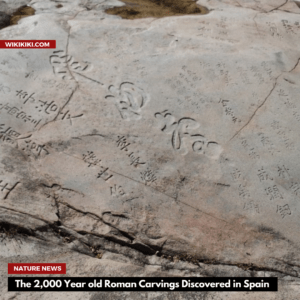The recent discovery of 2,000-year-old Roman carvings in the historic Tossal De La Cala fort in Benidorm, Spain, has captured the attention of archaeologists and historians alike. These Roman carvings, featuring a smiley face, a phallus, and a cornucopia, hold great significance and pose intriguing questions about their purpose and symbolism. In this article, we delve into the meaning behind these ancient drawings, exploring their potential ritualistic value, symbolic interpretations, and historical context.
Also Read: New Dinosaur Species Reveals Clues about Spinosaurus History

The Ancient Roman Carvings
Archaeologists came across the unique carvings during excavations at the Tossal De La Cala fort, located just three miles away from the lively party strip of Benidorm. The discovery, made over three years ago, remained discreet until recently due to preservation considerations and the challenges of exhibiting the Roman carvings without compromising the historic area.
The Roman carvings, known as “inscultura,” depict three human faces, a phallus, and a cornucopia. The find was described as having remarkable historical significance, as nothing similar had been discovered in the area before.
Deciphering the Symbols
The smiley face, one of the Roman carvings found, presents a mystery in terms of its purpose and significance. It may have had ritualistic value or could simply be ancient graffiti left behind by individuals.
The phallus, on the other hand, was regarded by the Romans as a vital symbol of the state’s safety and masculine power. Depictions of phalluses were common during the Roman era, appearing in furniture, lamps, and jewelry. Phalluses with wings often symbolized fertility and divinity in various ancient depictions, and some were even used as lucky charms. Therefore, the presence of the phallus in the carvings suggests a potential protective significance.
The cornucopia, a symbol of abundance and prosperity, is another mysterious addition to the Roman carvings. In Roman coins and reliefs, deities associated with spiritual abundance and harvest are often depicted carrying a cornucopia. The legend of Heracles, or Hercules, breaking off a horn from the river god Achelous also adds to the mythology surrounding the cornucopia.
Also Read: Mona Lisa Painting: Italian Historian Solved the Mystery of the Bridge
Speculations and Interpretations
Ritualistic Significance: One possibility is that the Roman carvings had ritualistic meaning. Ancient cultures often used symbolic representations in rituals and ceremonies. In the context of Roman culture, these carvings might have been associated with rituals related to fertility, protection, and abundance.
Graffiti or Personal Expression: Another perspective is that the carvings were expressions of individual creativity or boredom. Roman soldiers, in particular, engaged in artistic expression, and it is not uncommon to find examples of their graffiti. The carvings could be a product of personal creativity or an attempt to alleviate boredom during their time at the fort.
Historical Context: Tossal De La Cala and its Significance
The Tossal De La Cala fort, where the Roman carvings were discovered, has historical significance as a Roman settlement that was occupied by the armies of Quinto Sertorio during the Sertorian Wars. Quinto Sertorio, a prominent Roman statesman and military commander, rebelled against the Roman government and formed alliances with local tribes in Hispania (present-day Spain).
The Roman carvings provide a glimpse into the dramatic history of the fort and the power dynamics that characterized Roman society during that time. Whether they represent protective symbols, ritualistic artifacts, or mere expressions of artistic creativity, they contribute to our understanding of ancient Roman culture.
Comparisons and Uniqueness of the Roman Carvings
The absence of similar carvings adds to the historical significance of the discovery. No parallel references to engravings or reliefs of similar composition have been found in ancient Roman territories. The uniqueness of these carvings enhances their importance in expanding our knowledge of ancient Roman culture and practices.
Also Read: The Origin and Evolution of Chocolate: A Brief History
Conclusion
The 2,000-year-old Roman carvings discovered at the Tossal De La Cala fort in Benidorm, Spain, continue to captivate researchers and spark curiosity about their true meaning. These enigmatic symbols, including a smiley face, a phallus, and a cornucopia, provide a fascinating glimpse into ancient Roman culture and belief systems.
While the purpose of these carvings remains a mystery, they offer various interpretations. The presence of the phallus suggests a protective significance, symbolizing masculine power and safety. The cornucopia, on the other hand, represents abundance and prosperity, possibly associated with deities linked to harvest and spiritual wealth.
The combination of these symbols, along with the human face, raises intriguing possibilities. Some researchers speculate that they could represent a specific Roman god or goddess, such as Priapus, known for fertility and abundance. Others suggest that the carvings might be the product of bored Roman soldiers, leaving behind their artistic mark on the rock.
Regardless of their exact meaning, the discovery of these carvings holds remarkable historical significance. The Tossal De La Cala fort itself has a rich history, once occupied by Quinto Sertorio during the Sertorian Wars. These carvings provide a window into the tumultuous times of rebellion and power struggles in ancient Rome.
As archaeologists continue to study and analyze these ancient carvings, they deepen our understanding of Roman society, its cultural practices, and the beliefs that shaped their worldview. The ongoing excavation and preservation efforts at Tossal De La Cala offer hope for further discoveries and insights into the complex tapestry of the past.
In conclusion, the 2,000-year-old Roman carvings found in Benidorm, Spain, remain a fascinating enigma. They remind us of the enduring mysteries that lie beneath the surface of history, waiting to be unearthed and shed light on the diverse and intricate cultures that have shaped our world.
Also Read: Brain Implants Enable Paralyzed Individuals to Walk Again



















+ There are no comments
Add yours